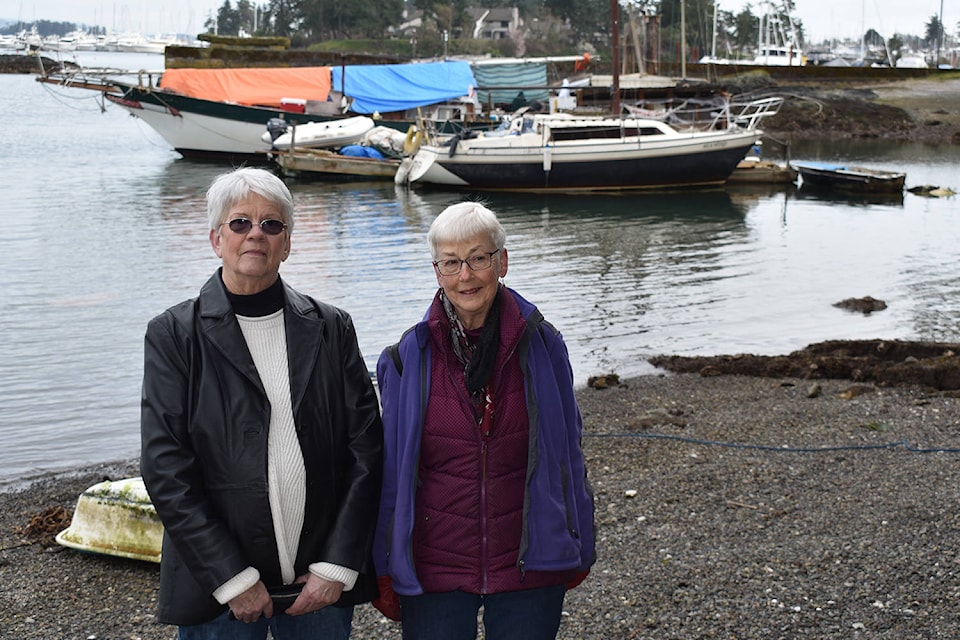Family members of Lillian Hoffar, the namesake of a park in North Saanich, wants the municipality to crack down on individuals who live on board vessels moored within municipal boundaries.
“I now feel that [the municipality] should take a stand,” said Catherine Campbell, one of four grandchildren of Lillian and Henry Hoffar, a local boat builder and aviation pioneer, who donated the land to North Saanich as park. “It has gone on long enough,” said Joan Wilkening, Campbell’s cousin. “It is going to get worse,” added Campbell.
The women made those comments while sitting in the park, overlooking a collection of boats moored just off shore. Stewart Jackson, who spoke with the Peninsula News Review in late February, owns two of the three boats moored, with another boat belonging to his son.
Jackson told the Peninsula News Review earlier that he had been living on the water for about four years with his wife and pet, much to the growing chagrin of Campbell and Wilkening.
“We feel that this area in the bay really belongs to the park, and it is not fair that he is being allowed to live there for free,” said Campbell. “He is not paying anything to the District of North Saanich. He is polluting the water. It is a dangerous condition,” added Wilkening.
RELATED: North Saanich man fears tougher moorage policies could cost him his home
Campbell and Wilkening expressed these concerns as the District of North Saanich plans to toughen its moorage policy.
Municipal officials have grown more concerned about the state of nearby Tsehum Harbour in the face of more than 30 sunken boats, according to one estimate, and other moorage issues. A recent staff report notes that around 100 mooring buoys currently float within Tsehum Harbour, with the majority of buoys satisfying North Saanich’s existing zoning bylaw.
While the regulation of navigation and shipping falls exclusively within federal jurisdiction, court cases have confirmed that municipalities may regulate through zoning land use covered by navigable water.
Specifically, the Community Charter gives municipalities the authority to regulate land covered by water up to 300 metres from the high water mark of municipal boundaries. The incorporation patent of North Saanich confirms that it includes the land covered by water to 300 metres from the high water mark.
Jackson’s boats appear — at least on first glance — to lie within this zone, prompting Campbell to complain about an “invasion” of the park. “The purpose of the park is not to house people … that includes, as far as I am concerned the water.”
Jackson is currently not living on board the vessels as he is recovering from a leg amputation. The District communicated through its spokesperson that the eventual fate of the three boats “is not just a matter of dealing with abandoned vessels” because of the people who are living aboard.
“Housing issues need to be addressed for these individuals,” Rebecca Penz, the municipality’s communication manager, said last month.
“We have been working with the RCMP on enforcement and engaging with various social support services including the Homeless Action Response and CRD Housing to connect those living aboard with services to assist them with finding alternate housing,” she said. “In regards to environmental issues, we have not had any concerns brought forward. We are still assessing the situation and considering our options for next steps.”
RELATED: North Saanich council looks to navigate future of Tsehum Harbour
Campbell acknowledged Jackson’s right to a home. “People have human rights,” said Campbell. “If somebody has nowhere else to live than you cannot remove [them]. But he could move out to the bay.”
Wilkening also pointed out that Stewart had told the Peninsula News Review that he could live on land, when pressed. With the proper equipment, Jackson could live on the water but outside the confines of the park, said Wilkening.
Campbell and Wilkening said they would be just as concerned about the state of the bay if the park did not bear the Hoffar name, but acknowledge that the issue has an undeniable personal dimension.
Their respective fathers built the break water that juts out in the water near Jackson’s boats, which are moored to pilings dating back to the days when the Hoffars build boats in the area. The ashes of Campbell’s mother, as well as the cousins’ grandmother, Lillian Hofer, were spread near the site of a memorial tree, itself marked with a memorial stone.
“I don’t feel it’s fair for anybody to be polluting this beautiful bay,” said Campbell. “My grand-parents gave this to be a park, a bird sanctuary, something for the public to use and to enjoy and I’m sure that the people along the shore are not happy to looking at this too. I’m sorry he has medical issues, but this gone on for four years.”
Like us on Facebook and follow @wolfgang_depner
